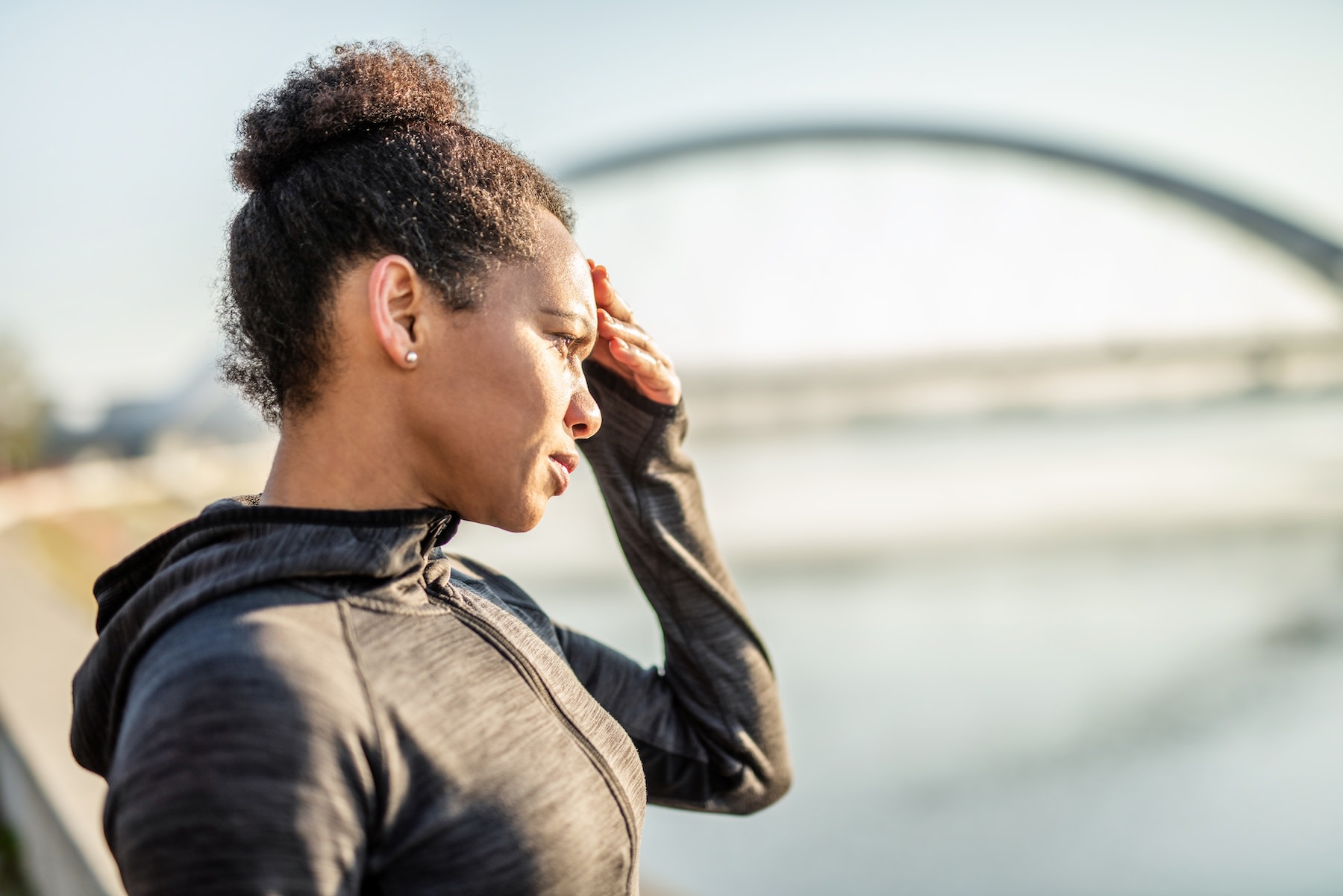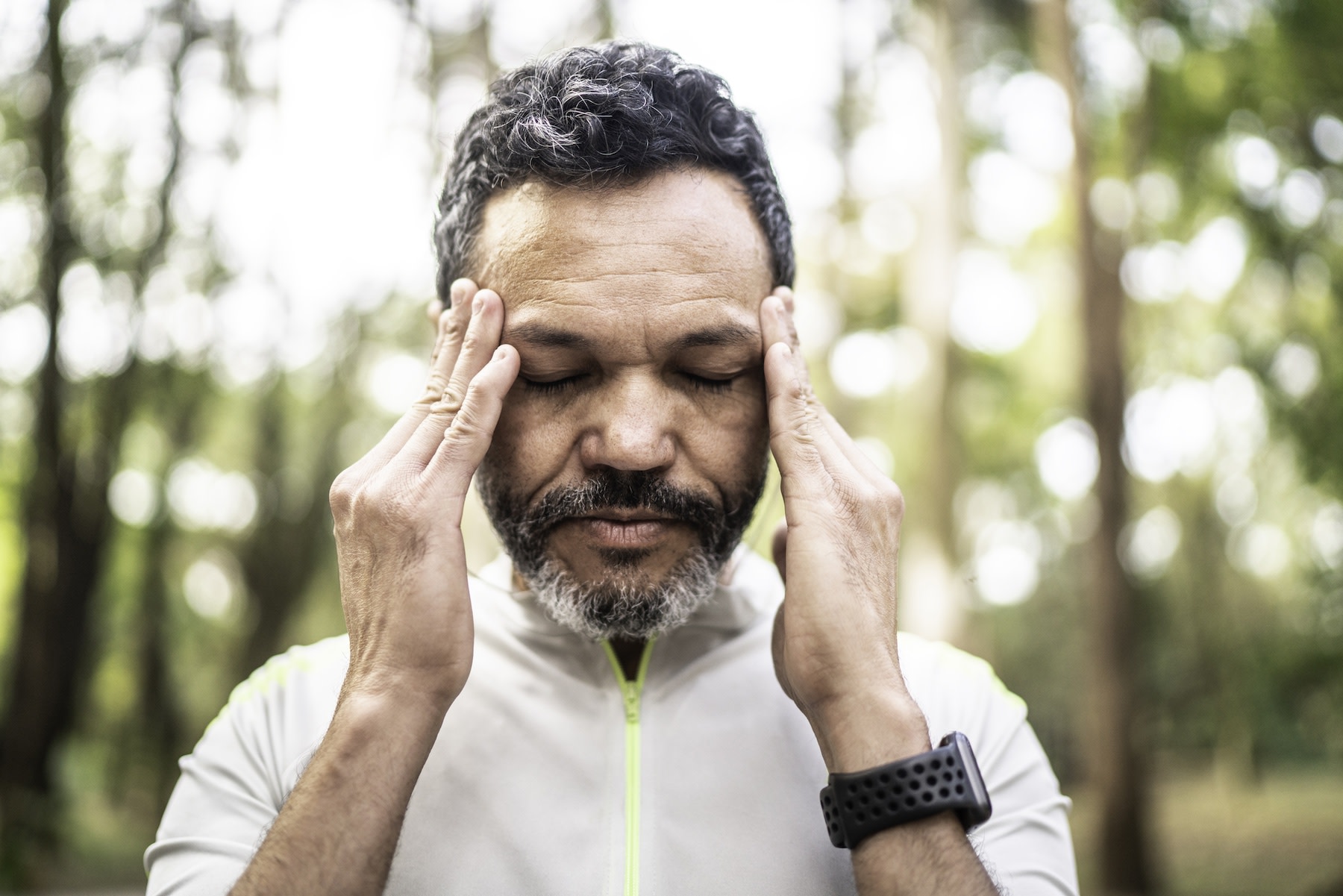
DjelicS / iStock / Getty Images Plus via Getty Images
How to Prevent a Headache After a Workout, According to Doctors
Because the last thing you need is head pain after a tough workout.
By Blake Bakkila•
What Are Workout Headaches?
Why Do Exertion Headaches Happen?
Are Certain Workouts More Likely to Give You an Exertion Headache?
How to Treat Exercise Headaches
Can You Prevent Headaches After Workouts?
When to Talk to Your Doctor About Exercise Headaches
The Takeaway
After pushing yourself during an intense workout, all you really want to do is enter recovery mode. But what happens if you experience a headache after your workout?
Chances are it could be an exercise or exertion headache, a rare yet incredibly frustrating problem among athletes. There are a few different symptoms that can signal exactly what type of headache you’re experiencing and, fortunately, a variety of preventative measures to fend off an exercise-induced headache.
To understand more, we spoke with two doctors about why headaches after workouts may happen, treatment and prevention tips, and when it’s time to reach out to your healthcare provider.
What Are Workout Headaches?
Healthcare providers often group exercise-induced headaches into two different categories: primary and secondary. As the Mayo Clinic notes, primary exercise headaches are typically harmless and involve head symptoms only, while secondary exercise headaches come with other symptoms and could be linked to an underlying, potentially serious problem. A primary exercise headache also shouldn’t be confused with an exercise-induced migraine, says Cara J. Hall, MD, sports medicine specialist with Keck Medicine of USC, who also works with USC Athletics and the Los Angeles Kings hockey team.
Key markers of a primary exercise headache include:
Bilateral pain, meaning it affects both sides of the head
Pulsating or throbbing pain
Lasts anywhere from five minutes to 48 hours
By contrast, a secondary headache or migraine may come with the following additional symptoms:
Unilateral pain, meaning it affects one side of the head
Nausea or vomiting
Neck stiffness
Double vision
Sensitivity to light or noise
Loss of consciousness
Because there are other underlying causes associated with secondary exercise headaches, we’ll focus on how to treat and prevent primary exercise headaches in this article. If you think your symptoms fall into the secondary exercise headache category, you may require immediate medical attention.
Why Do Exertion Headaches Happen?
While there are a number of factors that could contribute to a headache after a workout—such as working out too hard, not drinking enough water, or exercising in extreme weather or high altitude—the exact cause is unknown.
“There are a few different theories, which basically have to do with some sort of cardiovascular dysfunction or dysregulation while exercising,” Dr. Hall says.
One specific theory is that “strenuous exercise dilates blood vessels inside the skull to increase blood flow to the brain in order to meet the increased demand for oxygen,” says Raj Dasgupta, MD, a quadruple board-certified physician who specializes in internal medicine, pulmonology, critical care, and sleep medicine. “That expansion of the blood vessels and subsequent increase in blood pressure creates pressure in the skull, which causes the pain and headache.”
All that said, certain risk factors can make you more prone to experiencing a primary exercise headache. These might include:
Overexertion: “When you’re exercising intensely, more blood rushes to your brain, which can make the blood vessels there expand and cause pain,” Dr. Dasgupta says, adding that “another possible reason is the tense muscles in your neck and upper body from tough workouts.”
Dehydration: “If you’re not drinking enough water before or during your workout, it can affect your body’s balance of fluids and salts, possibly leading to these headaches,” Dr. Dasgupta says.
Exercising at a high altitude: Traveling to a high altitude and not giving your body enough time to adjust could induce a headache after exercise.
Extreme weather: Weather conditions, particularly warm climates, may make athletes more prone to getting a headache after a workout.
In addition to these risk factors, Dr. Dasgupta says that a history of high blood pressure and stress or anxiety while working out can also bring on headache symptoms.
Are Certain Workouts More Likely to Give You an Exertion Headache?
Exercises that involve overexertion or stress on the body can increase your likelihood of getting a headache after a workout. More strenuous activities like running, high-intensity interval training (HIIT), and heavy weightlifting can trigger these headaches because of increased blood pressure, and because you may be performing the Valsalva maneuver during exercise, according to Dr. Dasgupta.
“This maneuver is a technique that involves exhaling against a closed airway, which can cause an increase in blood pressure,” Dr. Dasgupta says. During a workout, you might trigger the Valsalva maneuver by engaging in activities that require you to exhale against resistance, such as lifting heavy weights or doing sit-ups, he explains. Engaging in this “bearing-down sensation,” as Dr. Hall describes it, might prompt an unwelcome headache after your workout.
How to Treat Exercise Headaches
One person’s exercise headache may be different than their gym buddy’s, especially because the timeframe for a primary exercise headache is such a wide range. (Remember, it can last anywhere from five minutes to 48 hours.) While Dr. Hall says it’s best to try to prevent exercise-induced headaches from happening in the first place, there are some ways to treat them when they strike.
While you should always talk to your doctor about the right treatment plan for you, here are a few general tactics to keep in mind, according to Dr. Hall and Dr. Dasgupta:
Hydrating
Decreasing the intensity of your workout, or stopping your workout early
Trying an over-the-counter pain reliever, such as acetaminophen, ibuprofen, or naproxen
With these methods in mind, remember that preventative care is best for exercise headaches, according to both experts we spoke with. “When you’re doing it after the fact, especially with hydration, it’s just a little less successful,” Dr. Hall explains.
If your headache lasts longer than 48 hours, you can generally rule out a primary exercise headache. Whichever type of headache you think you might have, it’s always best to speak with your doctor about the best treatment options for you. Once again, the options listed above are generally recommended by our experts, but they may not work for you and your specific health concerns.

FG Trade / E+ via Getty Images
Can You Prevent Headaches After Workouts?
Dr. Hall says that preventing future headaches is not only possible, but it’s also your best course of action. Why? It’s significantly more difficult to treat an exercise headache once it sets in.
Here are some tried-and-true preventative measures to ward off a potential exertion headache, according to our experts:
Warm up before exercising. Dr. Dasgupta says a proper warm-up before your workout can help alleviate exercise headaches.
Drink more water, ideally with electrolytes. “Making sure you’re hydrated before you exercise makes sure your fluids are balanced,” Dr. Hall says.
Choose a cooler workout environment. Because there are links to headaches in warm weather, try to find an indoor gym or more temperature-regulated area to perform your exercise routine if possible.
Maintain good posture. Poor posture is also attributed to causing a workout-induced headache, according to Dr. Dasgupta.
Don’t push yourself too hard. While you might want to put everything you have into your workout, avoid overexertion. Dialing it back and decreasing your intensity can potentially prevent a headache after exercise.
Prepare for training at high altitudes. “If you are going to do a workout in high altitude, I would take a while to acclimate before doing the workout,” Dr. Hall says. “For a few days, just do your everyday activities and not something super intense for your first workout. Build up to it.”
Get enough high-quality sleep. “This is more for migraines, but for people who are headache-prone, sleep is super important,” Dr. Hall says. Dr. Dasgupta also adds that “getting good quantity and quality sleep” is essential.
Your healthcare provider may also recommend an over-the-counter or prescription anti-inflammatory (or another type of medication) that you can take before exercising, Dr. Hall notes—but as always, talk to your doctor to see what’s best for you.
With these words of wisdom, you can hopefully give yourself the best workout environment and experience possible. Preparation is key here, and again, don’t hesitate to reach out to your doctor for more specific care for any exercise headache concerns.
When to Talk to Your Doctor About Exercise Headaches
Both Dr. Hall and Dr. Dasgupta agree that most exercise-related headaches should be discussed with your doctor—especially if they are persistent, severe, sudden, or associated with fainting or feeling confused. The Mayo Clinic also advises seeking medical attention if it’s the first time you’ve had this type of headache.
What’s more, if you’re experiencing headaches after working out, get evaluated by a doctor to confirm that it’s a primary (and not a secondary) exercise headache. Dr. Hall says that primary exercise headaches can also be associated with cardiac risk factors, so it’s also important to verify that your blood pressure and cholesterol are both under control. You should also seek out a neurologist who has advanced training in headache medicine.
“It’s a diagnosis of exclusion,” Dr. Hall says. “A lot of the time, we end up ordering head imaging to prove it’s the primary exercise-induced headache. That might be as simple as a brain MRI or a CT of the head, and just running different labs to check out someone’s cardiovascular risk factors.”
The Takeaway
A headache after a workout can be extremely frustrating, but if you’re struggling from a primary exercise headache—which usually comes with throbbing pain, is felt on both sides of the head, and lasts up to 48 hours—know that it’s usually harmless. While the exact cause of exercise headaches is unknown, you may be more likely to experience a post-workout headache due to overexertion, dehydration, or exercising in high altitude or extreme weather. Prevention methods like drinking enough water, warming up before a workout, and not pushing yourself too hard are key to warding off a headache after exercise.
All that said, if you’re working out and experience a headache afterward, it’s not something to ignore. Even if you think it qualifies as a primary exercise headache, you’ll want to check in with a healthcare professional—ideally a neurologist—who can give you a proper diagnosis and recommend treatment and preventative care. Personalized advice from a doctor is always encouraged, and it may allow you to address other potential concerns involving your blood pressure or cholesterol, among other concerns. In extreme situations, it could also lead to a secondary exercise headache diagnosis, which may require immediate medical attention.

Peloton App
Access thousands of classes with no equipment needed.
This content is for informational and educational purposes only and does not constitute individualized advice. It is not intended to replace professional medical evaluation, diagnosis, or treatment. Seek the advice of your physician for questions you may have regarding your health or a medical condition. If you are having a medical emergency, call your physician or 911 immediately.
This content is for informational and educational purposes only and does not constitute individualized advice. It is not intended to replace professional medical evaluation, diagnosis, or treatment. Seek the advice of your physician for questions you may have regarding your health or a medical condition. If you are having a medical emergency, call your physician or 911 immediately.
Get our latest health stories straight to your inbox
Enter your email to get articles, expert-backed tips, and updates from Peloton sent to your inbox.
By providing your email address, you agree to receive marketing communications from Peloton.
For more about how we use your information, see our Privacy Policy.





